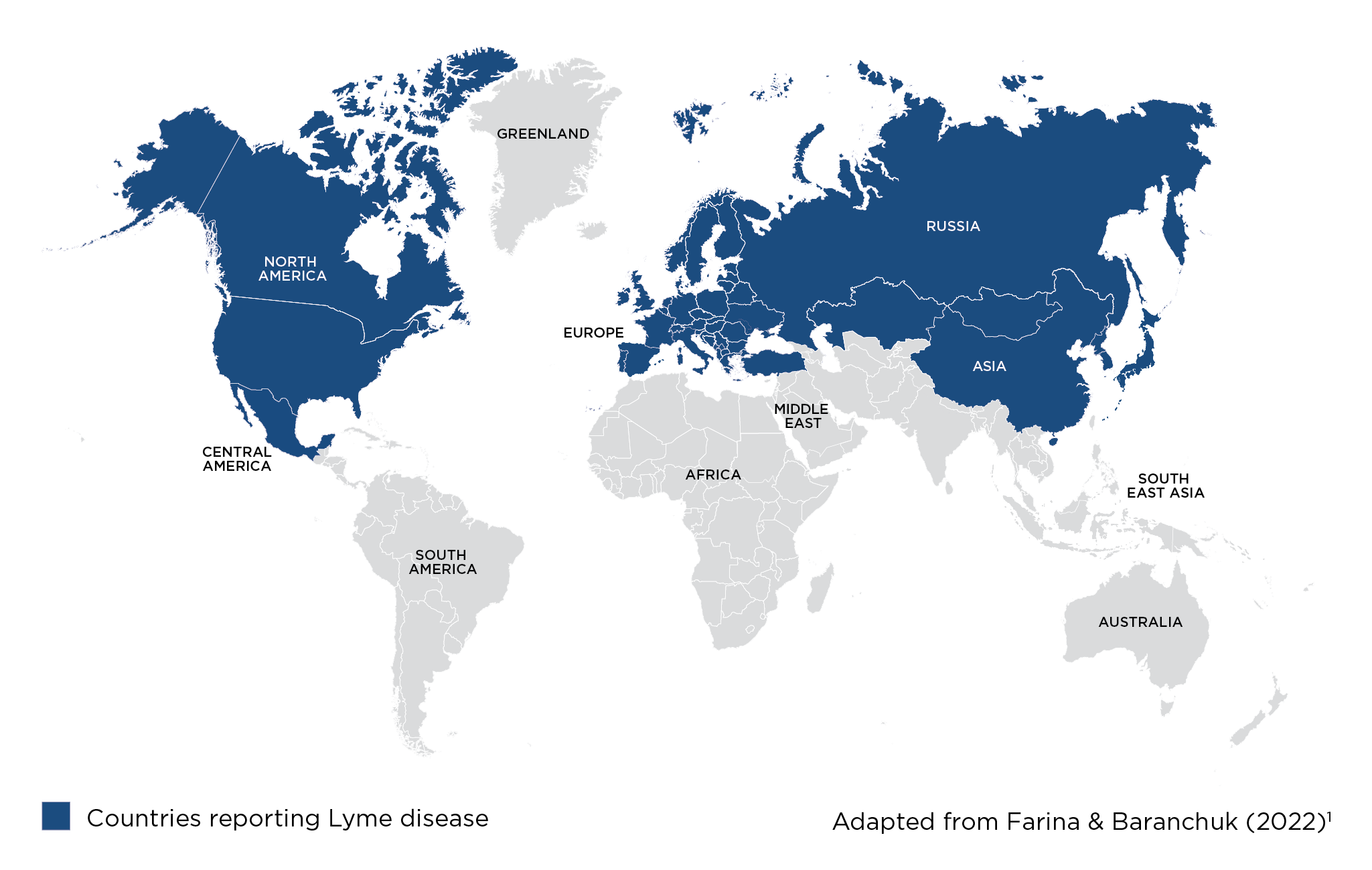In most people who have been infected, a red, bulls-eye shaped rash develops within 30 days of the tick bite.2
Risk areas for Lyme Disease

FAQs
-
Key fact
-
How do people catch Lyme disease?
Being bitten by an infected tick which carries the bacteria which cause Lyme Disease. Ticks are usually found in wooded, brushy, or grassy areas.3,4
-
Which countries are affected by Lyme disease?
Northern hemisphere countries from North America through Europe to Russia and China (see map).1,3 Lyme disease is the most common tick-borne disease in Europe and the UK.5
-
What are the symptoms of Lyme disease?
Most people who have been infected develop a rash that gradually expands around the bite. They may also have fatigue, fever, headache and joint and muscle pain.2,6
-
How serious is Lyme disease?
Lyme disease can be treated with antibiotics. If untreated, it may eventually cause arthritis and possibly also problems with the skin and nervous system.2
-
Can I prevent getting Lyme disease?
You can take the following precautions to help reduce your risk of infection:
- Visit your nearest convenient pharmacy or specialist travel health clinic for a risk assessment before your trip
- Avoid places – like long grass – where ticks live4,6
- Use a recommended insect repellent containing either Picaridin, DEET, PMD or OLE (oil of lemon eucalyptus), IR3535 or 2-undecanone4
- Wear appropriate clothing (e.g loose fitting long-sleeved clothes, long trousers, socks and shoes) and tuck trousers into socks to minimise exposed skin6
- Check every day for ticks on yourself, children and pets. Carefully remove any that you find using a tick remover or tweezers. Gently grip the tick as close to the skin as possible and pull it upwards without twisting or crushing. Then wash your skin with water and soap or an antiseptic.6
Ready to get started? Check now for your nearest travel health clinic.
Get friendly advice from the UK's largest network of travel clinics*.
* This list is not exhaustive and other travel health providers are available.
References
- Farina JM, Baranchuk A. Lyme Diseases Epidemiology: Update 2022. In Lyme Carditis From A to Z . Eds Baranchuk A, Wamboldt R, Wang CN. Springer, 2023.
- European Centre for Disease Prevention and Control. Factsheet about Borreliosis. March 2016. Available online: https://ecdc.europa.eu/en/borreliosis/facts/factsheet (Last accessed May 2025)
- Centers for Disease Control and Prevention. Yellow Book 2026. Post-Travel Evaluation. Post-Travel Dermatologic Conditions. April 2025. Available online: https://www.cdc.gov/yellow-book/hcp/post-travel-evaluation/post-travel-dermatologic-conditions.html (Last accessed May 2025)
- Centers for Disease Control and Prevention. Yellow Book 2026. Section 4 Environmental Hazards and Risks. Mosquitoes, Ticks and Other Arthropods. April 2025. Available online: https://www.cdc.gov/yellow-book/hcp/environmental-hazards-risks/mosquitoes-ticks-and-other-arthropods.html (Last accessed May 2025)
- NaTHNA Diseases spread by insects and ticks in Europe. June 2024. Available online: https://travelhealthpro.org.uk/factsheet/48/diseases-spread-by-insects-and-ticks-in-europe (Last accessed May 2025)
- NHS. Conditions. Lyme disease. July 2021. Available online: https://www.nhs.uk/conditions/lyme-disease/ (Last accessed May 2025)
UK-BOTB-2500030 May 2025
